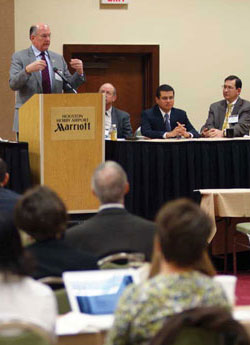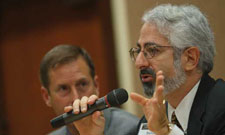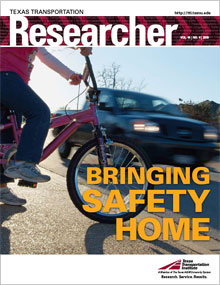
The inaugural gathering of traffic safety professionals, policymakers and practitioners was a rousing success, according to John Mounce, director of the Texas Transportation Institute’s (TTI’s) Center for Transportation Safety. Mounce moderated the conference.
The 2008 Traffic Safety Conference was held in Houston, Texas, Nov. 17-19, 2008. TTI hosted the event in conjunction with the Texas Department of Transportation (TxDOT) and the Houston-Galveston Area Council.
“We achieved our primary goal of bringing together various constituencies devoted to reducing fatalities on our highways,” explains Mounce. “Everyone at that conference was, in some way, a problem solver.”
The conference began with a video on crashes designed to show just how important getting the word out about traffic safety is. A recurring theme throughout was the importance of education and increased awareness in motivating individuals to take responsibility and help create a “safety culture” on the roadway. This term refers to an emerging philosophy that acknowledges the idea that engineering innovations and law enforcement can only do so much to keep drivers, pedestrians and riders safe. What is ultimately needed is a change in the way we, as individual users of the transportation system, view and use the system itself.
Speakers addressed a myriad of traffic safety issues, including impaired driving, motorcycle safety, young drivers, law enforcement, federal initiatives, alcohol/drug traffic offender adjudication, red-light camera enforcement, occupant protection issues for Texas and various emerging traffic safety issues.
Carlos Lopez, traffic operations director for TxDOT, noted that Texas is the only state where traffic deaths have actually declined five years in a row, even though the state’s population jumped from more than 20 million to more than 23 million between 2001 and 2006. Yet motorcycle-related fatalities have increased dramatically, as noted by Dr. Jeff Michael of the National Highway Traffic Safety Administration. Speaker after speaker noted that there is clearly room for improving safety in the Lone Star State, and motivating individual behavioral change is key to making that happen.

Texas State Representative Jim Murphy, member of the House Transportation Committee, spoke in the final session, devoted to state legislative issues. He reviewed the legislative agenda for 2009 and discussed the political realities that surround implementing safety solutions. Sometimes it’s not technical knowledge or even political will that’s the driving force in improving traffic safety. Sometimes it’s the “power of persistence” of the public in setting safety as a priority through legislation that really drives it forward.
“Many attendees, from many professions and levels of responsibility, were very complimentary of the forum and information shared here,” explains Mounce. “Based on the attendance and responses from attendees, I believe the next conference will be even more successful.”
